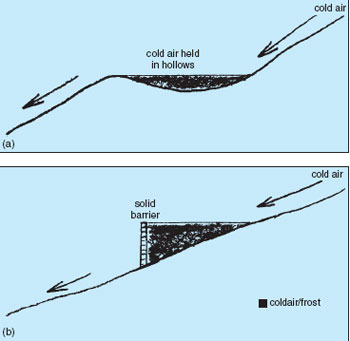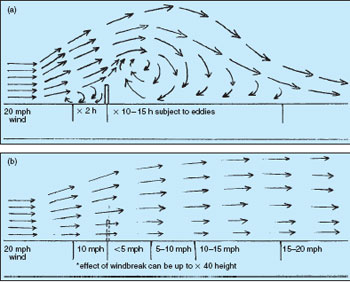Local climate
ContentMost people will be aware that even their regional weather forecast does not do justice to the whole of the area. The local climate reflects the infl uence of the topography (hills and valleys), altitude and lakes and seas that modifi es the general infl uence of the atmospheric conditions. Coastal areas These are subject to the moderating influence of the body of water. Water has a large heat capacity compared with other materials and this modifies the temperature of the surroundings. Altitude The climate of the area is affected by altitude; there is a fall in temperature with increase in height above sea level of nearly 1°C for each 100 m. The frequency of snow is an obvious manifestation of the effect. In the southwest of England there are typically only 5 days of snow falling at sea level each year whereas there are 8 days at 300 m. At higher altitudes the effect is more dramatic; in Scotland there are nearer 35 days per year at sea level, 38 days at 300 m, but 60 days at 600 m. The colder conditions at higher altitudes have a direct effect on the growing season. On the southwest coast of England there are nearly 365 growing days per year, but this decreases by 9 days for each 30 m above sea level. In northern England and Scotland there are only about 250 growing days which are reduced by 5 days per 30 m rise, i.e. to just 200 days at 300 m (1000 feet) above sea level in northern England. Topography
Air drainage Cold air tends to fall, because it is denser than warm air, and collects at the bottom of slopes such as in valleys. Frost pockets occur where cold air collects; plants in such areas are more likely to experience frosts than those on similar land around them. This is why orchards, where blossom is vulnerable to frost damage, are established on the slopes away from the valley floor. Cold air can also collect in hollows on the way down slopes. It can also develop as a result of barriers, such as walls and solid fences, placed across the slope (see Figure 2.10).
Microclimate The features of the immediate surroundings of the plant can further modify the local climate to create the precise conditions experienced by the plant. This is known as its microclimate. The significant factors that affect plants include proximity to a body of water or other heat stores, shelter or exposure, shade, altitude, aspect and air drainage. The modifications for improvement, such as barriers reducing the effect of wind, or making worse, such as barriers causing frost pockets, can be natural or artificial. The microclimate can vary over very small distances. Gardeners will be familiar with the differences across their garden from the cool, shady areas to the hot, sunny positions and the implications this has in terms of the choice of plants and their management. Growers improve the microclimate of plants when they establish windbreaks, darken the soil, wrap tender plants in straw, etc. More elaborate attempts involve the use of fleece, cold frames, cloches, polytunnels, glasshouses and conservatories. Automatically controlled, fully equipped greenhouses with irrigation, heating, ventilation fans, supplementary lighting and carbon dioxide are extreme examples of an attempt to create the ideal microclimate for plants. Heat stores are materials such as water and brickwork, which collect heat energy and then release it to the immediate environment that would otherwise experience more severe drops in temperature. Gardeners can make good use of brick walls to extend the growing season and to grow plants that would otherwise be vulnerable to low temperatures. Water can also be used to prevent frost damage when sprayed on to fruit trees. It protects the blossom because of its latent heat; the energy that has to be removed from the water at 0°C to turn it to ice. This effect is considerable, and until the water on the surface has frozen, the plant tissues below are protected from freezing.
The diagram also shows how turbulence can be created in the lee of the barrier, which can lead to plants being damaged by down forces. Solid materials such as brick and wooden fences create the most turbulence. In contrast, hedges and meshes fi lter the wind; the best effect comes from those with equal gap to solid presented to the wind. However, the introduction of a shelterbelt can bring problems if it holds back cold air to create a frost pocket. Shade reduces the radiation that the plant and its surroundings receive. This tends to produce a cooler, moister environment in which some species thrive (see ecology). This should be taken into account when selecting plants for different positions outside in gardens. The grower will deliberately introduce shading on propagation units or on greenhouses in summer to prevent plants being exposed to high temperatures and to reduce water losses. Plant selection The horticulturist is always confronted with choices; plants can be selected to fit the microclimate or attempts can be made to change the microclimate to suit the plant that is desired. Forecasting Not only is there an interest in weather forecasting in order to plan operations such as cultivations, planting, frost protection, etc., but also for predicting pest and disease attacks, many of which are linked to factors such as temperature and humidity. Examples of outbreaks and methods of predicting them, such as critical periods that are used to predict potato blight. |







